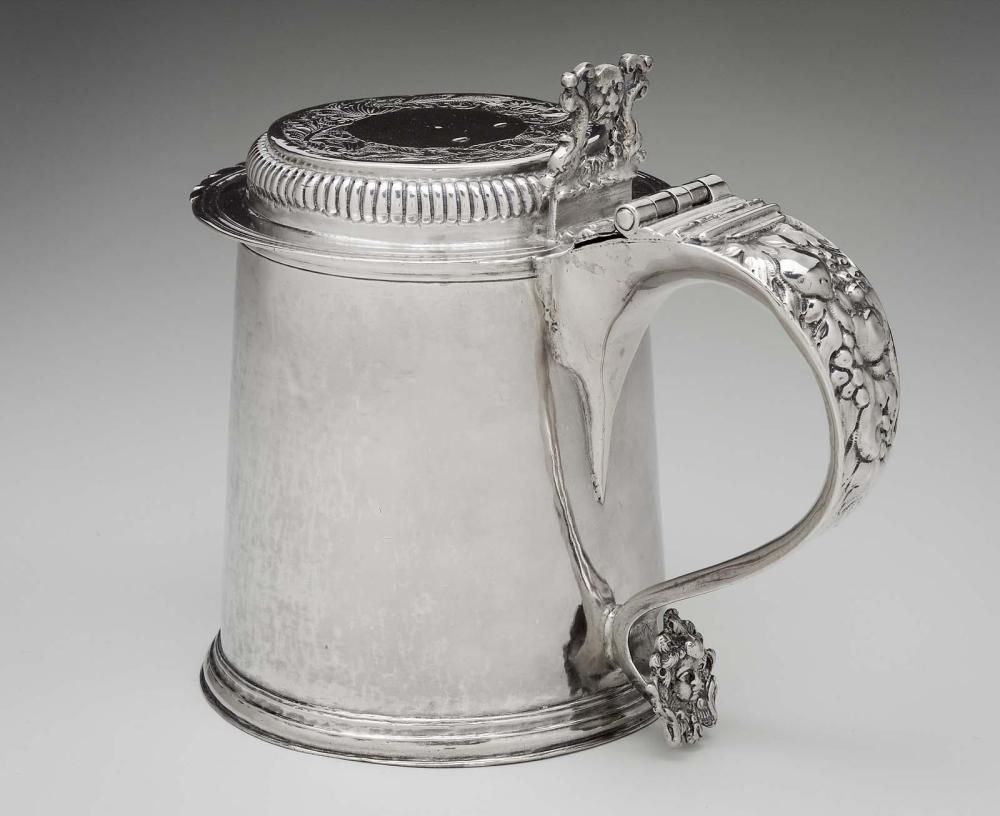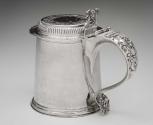Advanced Search
Tankard
Henry Hurst (American, born in Sweden, 1666–1717)
about 1700
Object Place: Boston, Massachusetts
Medium/Technique
Silver
Dimensions
Overall (h x dia. of base): 17.8 x 13.2 cm (7 x 5 3/16 in.); Other (dia. of lip): 11.1cm (4 3/8in.); Weight: 26 oz., 5 dwt.
Credit Line
Gift of Mr. and Mrs. Dudley Leavitt Pickman
Accession Number31.228
CollectionsAmericas
ClassificationsSilver hollowware
In seventeenth- and eighteenth-century America, the tankard was defined as "a large vessel with a cover, for strong drink," such as beer, ale, or hard cider. Silver examples varied greatly in size, from small tankards made for individual use to more capacious ones that held as many as four quarts to be passed from hand to hand around the table.
This tankard by Henry Hurst-one of only three known objects bearing his mark-is largely typical of Boston examples made in the late seventeenth and early eighteenth centuries, but the Swedish-style embossed fruit and foliage on its handle are extraordinary, perhaps even unique in American silver, because most American handle decoration is cast.
Hurst was born in Sweden, probably trained in Stockholm in the 1680s, and apparently worked as a journeyman in London in the 1690s. At the end of the century, Richard Conyers, a Boston goldsmith, contracted with Hurst to emigrate to America as his exclusive employee for two years, apparently recognizing Hurst's great skill in the specialty of chasing and embossing. Hurst and Conyers soon had a falling-out, and Hurst broke his contract. He then went to work in 1701 and 1702 for Edward Winslow. He may have been responsible for the elaborately chased sugar boxes that were produced in Winslow's shop at that time (see 42.251).
This text was adapted from Ward, et al., MFA Highlights: American Decorative Arts & Sculpture (Boston, 2006) available at www.mfashop.com/mfa-publications.html.
This tankard by Henry Hurst-one of only three known objects bearing his mark-is largely typical of Boston examples made in the late seventeenth and early eighteenth centuries, but the Swedish-style embossed fruit and foliage on its handle are extraordinary, perhaps even unique in American silver, because most American handle decoration is cast.
Hurst was born in Sweden, probably trained in Stockholm in the 1680s, and apparently worked as a journeyman in London in the 1690s. At the end of the century, Richard Conyers, a Boston goldsmith, contracted with Hurst to emigrate to America as his exclusive employee for two years, apparently recognizing Hurst's great skill in the specialty of chasing and embossing. Hurst and Conyers soon had a falling-out, and Hurst broke his contract. He then went to work in 1701 and 1702 for Edward Winslow. He may have been responsible for the elaborately chased sugar boxes that were produced in Winslow's shop at that time (see 42.251).
This text was adapted from Ward, et al., MFA Highlights: American Decorative Arts & Sculpture (Boston, 2006) available at www.mfashop.com/mfa-publications.html.
Catalogue Raisonné
Buhler, 1972, No. 64
DescriptionStraight tapering sides, moulded base & rim; flat top with serrated edge, reeded shoulder and chased border. Scroll handle embossed with fruit and flowers, rat-tail drop, cherub's head tip, reeded hinge, dolphin and mask purchase.
Marks
HH in shaped punch twice on cover and twice on side
Inscriptionson bottom TKT, AL and "Came into possession..."
ProvenanceEarly history unknown. (1) By descent to Sally Pickman Loring Dwight (1859-1913); May 5, 1916 lent by the Estate of Sally Pickman Dwight; May 17, 1918, transferred to the estate of their son Lawrence Dwight (1896-1918); June 28, 1918, returned to estate of Lawrence Dwight; by descent to his cousin; March 17, 1920, lent by Mrs. Dudley Leavitt Pickman to MFA; 1931, gift of Mr and Mrs Dudley Leavitt Pickman to MFA. (Accession date: May 7, 1931)
1: AL may be for Abigail Lindall, daughter of Timothy and Mary (Verin) Lindall, who m. in 1704, as his second wife, Benjamin Pickman II; their grandson Benjamin IV (1740-1819) m Mary Wiloughby (1744-1817); Benjamin IV's son Thomas (1773-1817), m. second Sophia Palmer (1786-1862); their daughter Mary Toppan (1816-1878), m. Dr. George Bailey Loring, 1851; their daughter Sally Pickman Loring (1859-1913), m. Theodore F. Dwight.
1: AL may be for Abigail Lindall, daughter of Timothy and Mary (Verin) Lindall, who m. in 1704, as his second wife, Benjamin Pickman II; their grandson Benjamin IV (1740-1819) m Mary Wiloughby (1744-1817); Benjamin IV's son Thomas (1773-1817), m. second Sophia Palmer (1786-1862); their daughter Mary Toppan (1816-1878), m. Dr. George Bailey Loring, 1851; their daughter Sally Pickman Loring (1859-1913), m. Theodore F. Dwight.







